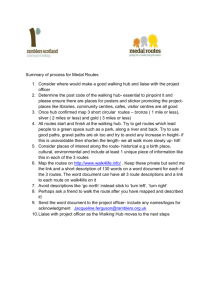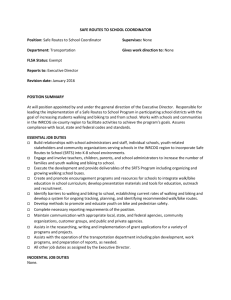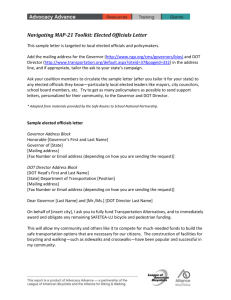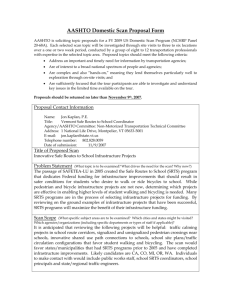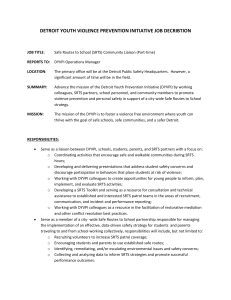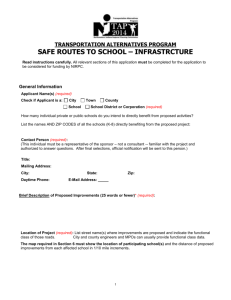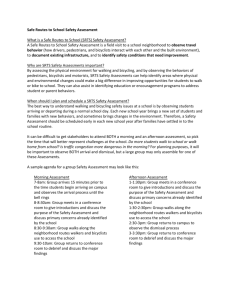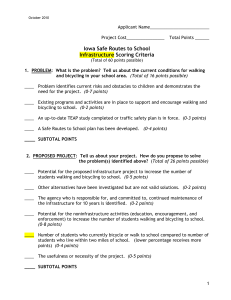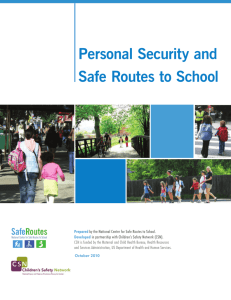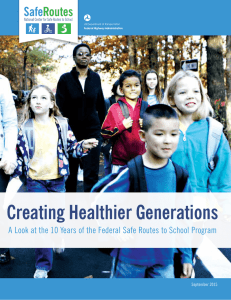Safe Routes to School The Role of Healthcare Professionals in
advertisement
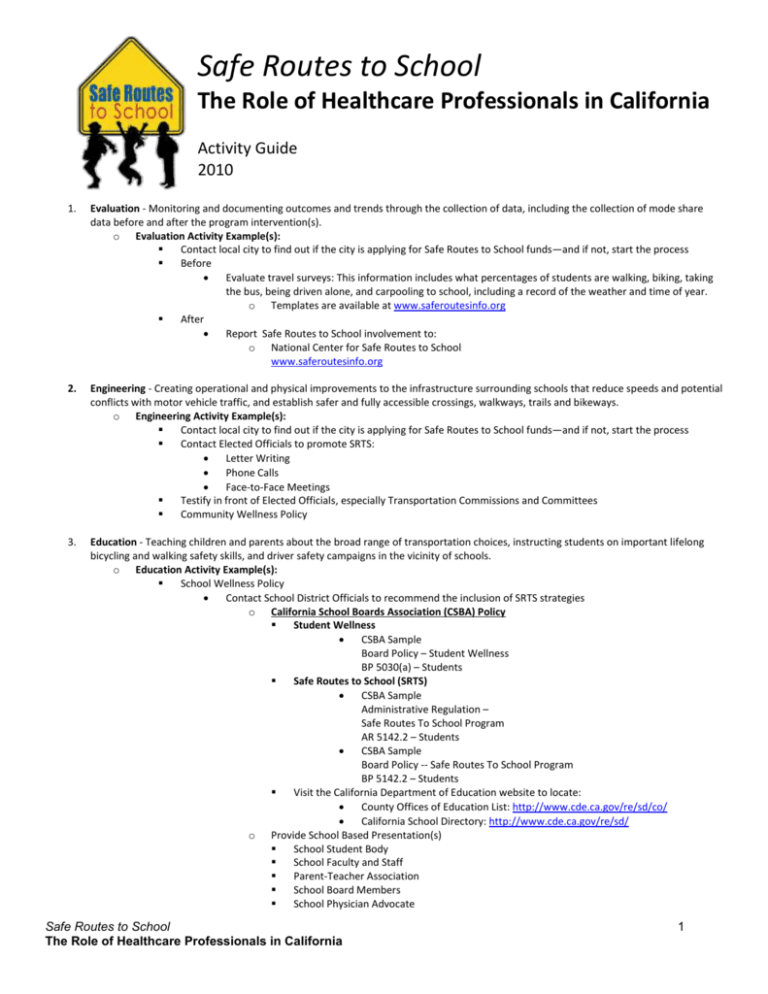
Safe Routes to School The Role of Healthcare Professionals in California Activity Guide 2010 1. Evaluation - Monitoring and documenting outcomes and trends through the collection of data, including the collection of mode share data before and after the program intervention(s). o Evaluation Activity Example(s): Contact local city to find out if the city is applying for Safe Routes to School funds—and if not, start the process Before Evaluate travel surveys: This information includes what percentages of students are walking, biking, taking the bus, being driven alone, and carpooling to school, including a record of the weather and time of year. o Templates are available at www.saferoutesinfo.org After Report Safe Routes to School involvement to: o National Center for Safe Routes to School www.saferoutesinfo.org 2. Engineering - Creating operational and physical improvements to the infrastructure surrounding schools that reduce speeds and potential conflicts with motor vehicle traffic, and establish safer and fully accessible crossings, walkways, trails and bikeways. o Engineering Activity Example(s): Contact local city to find out if the city is applying for Safe Routes to School funds—and if not, start the process Contact Elected Officials to promote SRTS: Letter Writing Phone Calls Face-to-Face Meetings Testify in front of Elected Officials, especially Transportation Commissions and Committees Community Wellness Policy 3. Education - Teaching children and parents about the broad range of transportation choices, instructing students on important lifelong bicycling and walking safety skills, and driver safety campaigns in the vicinity of schools. o Education Activity Example(s): School Wellness Policy Contact School District Officials to recommend the inclusion of SRTS strategies o California School Boards Association (CSBA) Policy Student Wellness CSBA Sample Board Policy – Student Wellness BP 5030(a) – Students Safe Routes to School (SRTS) CSBA Sample Administrative Regulation – Safe Routes To School Program AR 5142.2 – Students CSBA Sample Board Policy -- Safe Routes To School Program BP 5142.2 – Students Visit the California Department of Education website to locate: County Offices of Education List: http://www.cde.ca.gov/re/sd/co/ California School Directory: http://www.cde.ca.gov/re/sd/ o Provide School Based Presentation(s) School Student Body School Faculty and Staff Parent-Teacher Association School Board Members School Physician Advocate Safe Routes to School The Role of Healthcare Professionals in California 1 4. Encouragement - Using events and activities to promote and increase walking and bicycling, such as walk to school days, walking school busses and bicycle trains. o Encouragement Activity Example(s): Walk to School Month/Week/Day: October 4-8, 2010 Work With Currently Participating Schools Recruit New Schools to Participate Contact Elected Officials to promote SRTS Provide School Based Presentation(s) Media Involvement: Media coverage of the event brings visibility to the event’s purpose and any changes that need to be made to make it safer for kids to walk and bike to school. When media cover an event, they help spread the word of the great health, safety, environmental and social benefits of more children walking to school every day. o Press Release: The customizable local press release offers the media more detailed information on your Walk to School event, such as the impact it will have on the community or information on an ongoing program. To pitch walk to school programs and your event in particular, to the local media, use this press release. o Public Service Announcements: Public service announcements are a cost-effective method to partner with your local media to promote your Walk to School event. Call local radio stations, and ask to speak with someone in the public affairs department or the news department. Request an on-air reading of the PSA(s). o Media Advisory: The media advisory is simply meant to give the media all of the general details of your Walk to School event – this includes the who, what, when, where and significance of your event. o Talking Points: Talking points offer helpful information on topics such as trends in school travel, safety, physical activity, environment and air quality, background on the event, Safe Routes to School and a list of participating countries. You may find it helpful to use these for interviews with local media, meetings with parents or any other communications planned for the event. o Proclamation: Get public officials involved and bring visibility to your event by having your mayor or governor proclaim your walking date as the Official International Walk to School Day or Month for your community. Your proclamation can be customized to highlight the walking and biking issues that are important to your school and community, or to fit the dates you've chosen to celebrate. Walking School Busses Bicycle Trains 5. Enforcement - Partnering with local law enforcement to ensure traffic laws are obeyed in the vicinity of schools (including enforcement of speeds, yielding to pedestrians in crosswalks and proper walking and bicycling behaviors), stepping up law enforcement around schools to protect children and initiating community safety activities such as crossing guard programs. o Enforcement Activity Example(s): Contact Elected Officials to promote SRTS City councils County boards of supervisors, if living outside city limits o California Policy Example(s): AB 321 Safe Routes to School The Role of Healthcare Professionals in California 2 Safe Routes to School The Role of Healthcare Professionals in California Commitment to Change 2010 Please fill out this document and return it to the Obesity Prevention Project. Please save a completed copy of this document for your records. Check all you can commit and have interest in committing to with regard to the Regional Physician Advocates Project. Evaluation Activity Example(s): o o Encouragement Activity Example(s): o Evaluate travel surveys Report Safe Routes to School involvement to: Safe Routes to School National Center www.saferoutesinfo.org Engineering Activity Example(s): o o o Before After Contact Elected Officials to promote SRTS Letter Writing Phone Calls Face-to-Face Meetings Testify in front of Elected Officials Community Wellness Policy o o o Enforcement Activity Example(s): o Education Activity Example(s): o o School Wellness Policy Contact School District Officials to recommend the inclusion of SRTS strategies Testify at School Board Meetings Provide School Based Presentation(s) School Student Body School Faculty and Staff Parent-Teacher Association (PTA) School Board Members School Physician Advocate (i.e. Walk With Your Doc) Walk/Bike to School Month/Week/Day Work With Currently Participating Schools Recruit New Schools to Participate Contact Elected Officials to promote SRTS Provide School Based Presentation(s) Media Involvement Press Release Public Service Announcements Media Advisory Talking Points Proclamation Walking School Busses (i.e. Walk to School Wednesdays) Bicycle Trains Contact Elected Officials to implement and enforce SRTS City Councils County boards of supervisors, if living outside city limits California Policy Example(s): AB 321 Please send your completed document to: Vanessa S. Saetern, Project Assistant Obesity Prevention Project CMA Foundation Fax: 916.779.6658 Email: vsaetern@thecmafoundation.org Safe Routes to School The Role of Healthcare Professionals in California 3 As we move forward with this project, we would very much like to hear from you about the work you are doing and how we can continue to support your efforts. As you participate in activities, please contact the Obesity Prevention Project with updates and/or questions at (916) 779-6620. We look forward to hearing from you! THANK YOU! Safe Routes to School The Role of Healthcare Professionals in California 4
